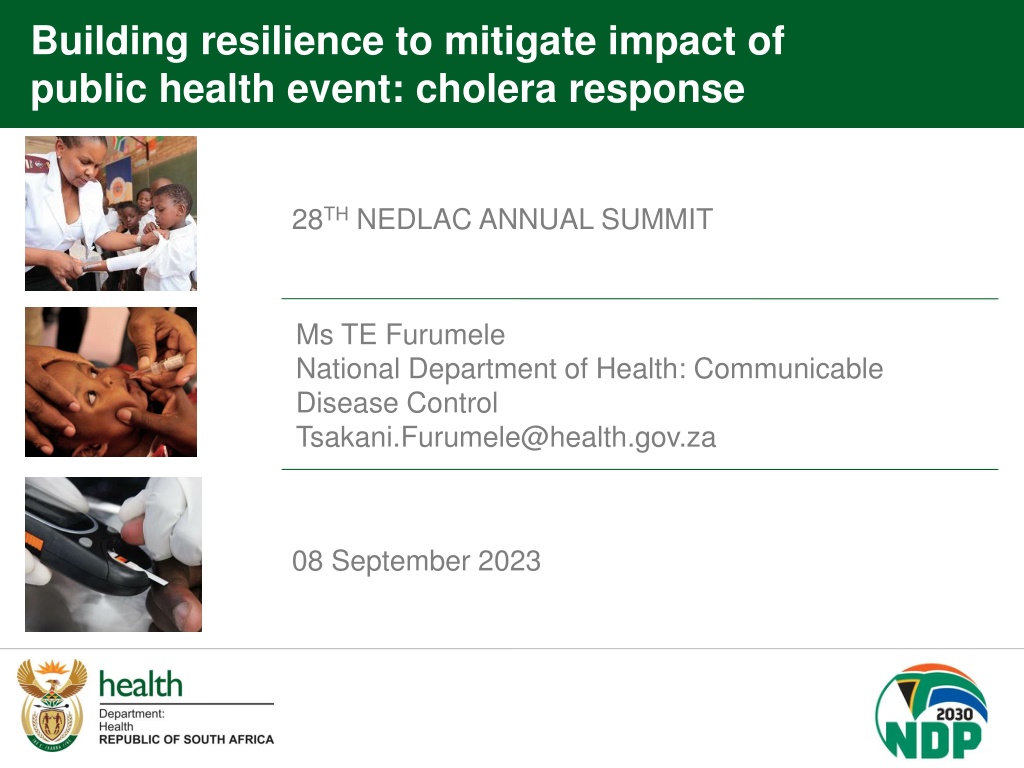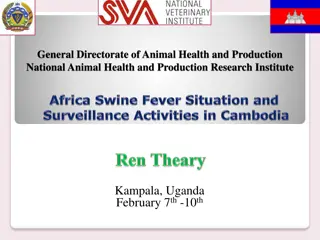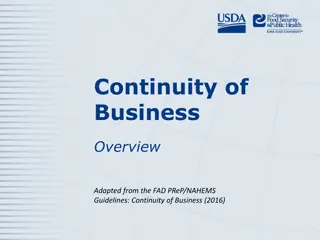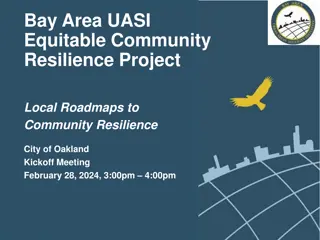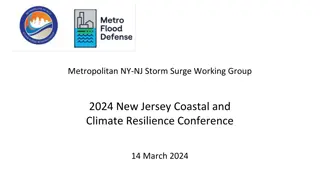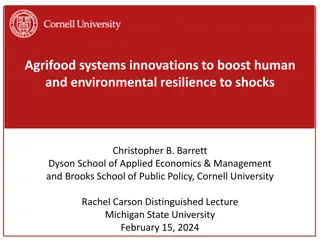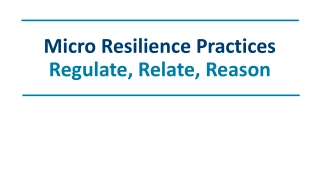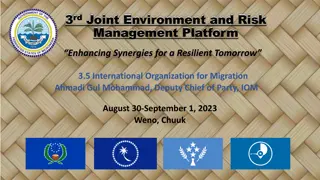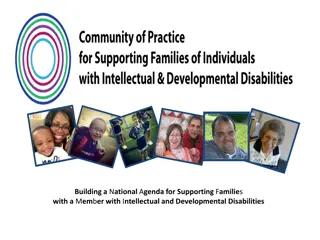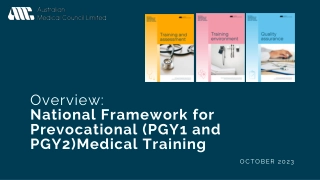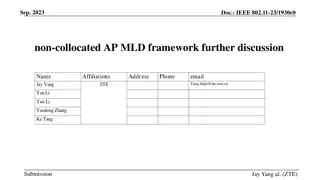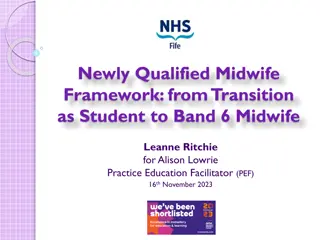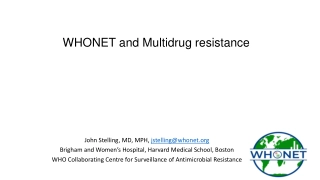Building Resilience Against Cholera Outbreaks: Lessons from IHR Framework
Exploring how the International Health Regulations (IHR) can enhance preparedness and response to cholera outbreaks. Discusses the functional components of IHR, the role of National IHR Focal Points, and best practices in building resilience. Highlights the importance of coordination, communication, and advocacy in mitigating the impact of cholera outbreaks.
Download Presentation
Please find below an Image/Link to download the presentation.
The content on the website is provided AS IS for your information and personal use only. It may not be sold, licensed, or shared on other websites without obtaining consent from the author. Download presentation by click this link. If you encounter any issues during the download, it is possible that the publisher has removed the file from their server.
Presentation Transcript
Building resilience to mitigate impact of public health event: cholera response 28TH NEDLAC ANNUAL SUMMIT Ms TE Furumele National Department of Health: Communicable Disease Control Tsakani.Furumele@health.gov.za 08 September 2023
Presentation outline Introduction IHR background Preparedness and Resilience for Emergency Threats (PRET) Cholera outbreak and response Best practices Recommendations Conclusion
International Health Regulations (2005) IHR (2005) are a legally-binding global health security framework whose purpose and scope are to prevent, protect against, control, and provide a public health response to the international spread of disease in ways that are commensurate with and restricted to public health risks and which avoid unnecessary interference with international traffic and trade. South Africa, as one of the Member States who are signatory to the Regulations, is expected to develop core capacities to prepare, detect, and respond to public health events. As part of the implementation of the IHR (2005), States Parties must designate National IHR Focal Points (NFP), as a single entry point for communication with WHO IHR Contact Points related to public health event notification, consultation, verification, information sharing, and determination of a potential Public Health Emergency of International Concern (PHEIC).
IHR Functional components 1. National Legislation, Policy and Financing 2. IHR Coordination, Communication and Advocacy 3. Antimicrobial Resistance (AMR) 4. Zoonotic Disease 5. Food Safety 6. Biosafety and Biosecurity 7. Immunization PREVENTION TECHNICAL WORKING GROUPS LEAD: NDOH COMMUNICABLE DISEASE CONTROL South Africa IHR NFP 1.Designated IHR NFP Responsible 2. NDOH Disaster Medicine 3. NDOH Zoonotic Diseases 4. NDOH Port Health 5. NICD Division of Public Health Surveillance and Response 6. IHR NFP Coordinator 7. IHR NFP Duty Officers DETECTION TECHNICAL WORKING GROUPS LEAD: NICD PUBLIC HEALTH SURVEILLANCE AND RESPONSE 1. National Laboratory System 2. Real Time Surveillance 3. Reporting 4. Workforce Development RESPONSE TECHNICAL WORKING GROUPS LEAD: NDOH DISASTER MEDICINE 1. Preparedness 2. Emergency Response Operations 3. Linking Public Health and Security Authorities 4. Medical Countermeasures and Personnel Deployment 5. Risk Communication OTHER IHR-RELATED HAZARDS TECHNICAL WORKING GROUPS LEAD: NDOH PORT HEALTH AND ENVIRONMENTAL HEALTH 1. Points of Entry (PoE) 2. Chemical Events 3. Radiation Emergencies
Cholera background Cholera is a diarrhoeal disease caused by a bacterium called Vibrio cholerae. The disease is able to cause large outbreaks and epidemics. Cholera outbreaks usually occur in the developing world and are associated with poor water, sanitation and hygiene infrastructures. Most persons infected with cholera will have very mild illness or not feel ill at all. Mild cholera presents as a diarrhoeal illness which can t easily be distinguished from other common causes of diarrhoea. In its severe form, cholera typically presents as follows: - sudden onset of illness - diarrhoea which is profuse, painless and watery, with flecks of mucus in the stool ("rice water" stools) - vomiting may occur, usually early in the illness - most persons don t have fever, although children may develop a fever - dehydration occurs rapidly and if untreated can be fatal
Rice water stool The appearance of stool in severe cases is classically described as rice water but in many cases with mild to moderate cholera the stool is watery but coloured and ANY acute watery stool, regardless of colour, must be regarded as suspected cholera
Cholera transmission The people most at risk of contracting cholera are those who do not have access to piped safe water and improved sanitation. Water contaminated with human faeces is the most important means of cholera transmission, either directly (through drinking contaminated water) or indirectly (through eating contaminated food). Water can be contaminated at its source, during storage or during use Food can become contaminated when it comes into contact with contaminated water. Vegetables that have been fertilised with human excreta (nightsoil) or "freshened" with contaminated water also become contaminated. Fish (particularly shellfish) sourced from contaminated water and eaten raw or insufficiently cooked may also cause infection Soiled hands can also contaminate clean drinking water and food
Cholera outbreak in South Africa On 1st February 2023 Gauteng Province reported two cases of cholera with a travel history to one of the neighbouring countries with an ongoing cholera outbreak. The South African Government officially declared the cholera outbreak on 5 February. Over the period February and March 2023, Gauteng Province reported eleven laboratory-confirmed cases and one death. With subsequent local transmission, 17 out of 52 districts in 5 provinces (Gauteng, Free State, Mpumalanga, North-West and Limpopo) reported cases. Among these five provinces originally affected, the last confirmed case of cholera was reported from Gauteng Province on 20 June 2023. KwaZulu Natal Province also reported an imported case on 18 July 2023 but that remained the only case with no local transmission. By 31July a total of 1,380 cholera cases (52% female, 199 laboratory confirmed), 320 admissions, 47 deaths, case fatality rate 3.4% had been reported in South Africa.
Components for Health Preparedness, and Resilience for Emerging Threats (PRET) 12 Core capacities, in line with the International Health Regulations (2005) are needed for respiratory pathogen pandemic preparedness, and specific actions can be taken to strengthen preparedness of each. To simplify planning and to align with global planning instrument, the 12 IHR (2005) core capacities can be organized according to five components for health emergency preparedness, response and resilience; namely Emergency Coordination Collaborative surveillance Community protection Clinical care Access to counter measures 10
Cholera Response according to the 5Cs COMPONENT IHR CORE CAPACITIES BEST PRACTICES DURING THE CHOLERA RESPONSE Emergency coordination Policy, legal and normative instruments Coordination Financing Human resources IHR (2005) Incident Management Teams (IMT at all levels Global Task Force on Cholera Control Guidelines Used Financial and human resources from NDOH, GP Health districts Collaborative surveillance Laboratory Surveillance One Health/ Zoonotic diseases NHLS peripheral laboratories NICD for genotyping Water quality testing 11
Cholera Response according to the 5Cs COMPONENT IHR CORE CAPACITIES BEST PRACTICES DURING THE CHOLERA RESPONSE IPC guidelines implementation Provision of safe drinking water Risk communication and community engagement Psychosocial support to bereaved families No vaccination PoE surveillance Community protection Infection prevention and control (in community settings) - Public health and social measures - Vaccination and chemoprophylaxis Risk communication and community engagement Points of entry and border health Clinical care Health Service provision Infection prevention and control (in health care facilities) Hospital admissions Kanana Treatment Uni Distribution of hygiene packs. Access to counter measures Health emergency management Kanana Treatment Unit 12
Public Health Response: Case management Kanana CTU
Public Health Response: Hygiene Packs Distribution MSF and UNICEF have donated 3,000 Hygiene Packs which are being distributed among the communities. A Standard Operation Procedure has been developed to guide the distribution of these packs. Packs were distributed to families where cases have been detected as well as homes within 50-meter radius. Each hygiene pack contains chlorine, sanitizer, washing powder (Oral rehydration Solution sachets, aqua tablets (water treatment tablets).
Best practices Integration of lessons learned from the COVID-19 response, incorporating concepts of the WHO Incident Management System (IMS) and rapid response strategies. Strong and present leadership from managers at all levels, contributing to the overall effectiveness of the response. Political commitment and leadership at presidency, national departments (Health, Water and Sanitation, and Social Development), provincial and local levels, further enhancing the response's effectiveness. Effective external communication and dissemination of information with partners and communities, including the media and press briefings. Promotion of interprovincial cross-border collaboration, such as between provinces like Northwest and Gauteng provinces, to enhance response coordination and resource sharing.
Recommendations Collective planning and response is critical for mitigating public health emergencies and building resilient systems. Intersectoral and multidisciplinary collaboration is key: - Maximize available resources - Reduce duplication of planning processes - No one is left behind
Conclusion Despite all the efforts by the different stakeholders the source of Cholera contamination has not yet been identified. However, the interventions have yielded positive results: it is more than ten weeks since a cholera case has been detected within our boundaries. The country is on high alert to detect and contain cholera . Any public health event, no matter how small, is an opportunity to strengthen our capacities to respond. Preparedness is not optional 36
